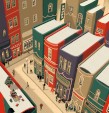In a move designed to revitalize its role as a resource center for photography and expand its book-publishing efforts, the Aperture Foundation has sold its five-story headquarters building in Manhattan's Flatiron district in New York City and announced plans to move to a 17,500-square-foot space in Chelsea in the spring of 2005.
The move signals Aperture's emergence from a period of reorganization following the deaths of Michael Hoffman, Aperture's longtime executive director, and Abrams CEO Paul Gottlieb, its director-designate, in 2001 and 2002, respectively. The move to W. 27th Street will place the foundation in the heart of Manhattan's premier art district and significantly expand its office and gallery space. The move also marks the expansion of its publishing program, including a new series of titles to be published in collaboration with George Eastman House, a nonprofit museum and educational institution devoted to photography.
Ellen Harris, executive director of the Aperture Foundation, said the real estate move was the result of senior staff rewriting and refocusing the mission statement of the 52-year old organization, as well as a new strategic plan. "When Aperture was founded, the audience for art photography was small," Harris explained. "Today no one questions that photography is art, and this move will put us in the epicenter of New York's art photography scene." She expects that Aperture's staff of 21 will move into the new space by March 2005.
Aperture will publish 12 new books this fall and 20 new titles in 2005. "After Michael Hoffman's death, our book program was rudderless," said Harris. "These are the first titles from our reorganized book program, and we'll stay at that number," she said. Earlier this year, Aperture switched its U.S. and international distribution to Thames & Hudson. "Our orders have quadrupled," she said, "and we're finding new markets in New Zealand, India and Australia."
In addition to the collaboration with Eastman House (which includes a book on the huge photo-murals that used to hang in Grand Central Station), Aperture is publishing new works of photography criticism and titles on the history of photography. Aperture will also greatly expand its exhibition schedule (the new space will have a 3,000-square-foot gallery) and public events and will partner with universities and major museums around the country.
"We're brushing ourselves off," said Harris, "and taking a look at the next 50 years."








